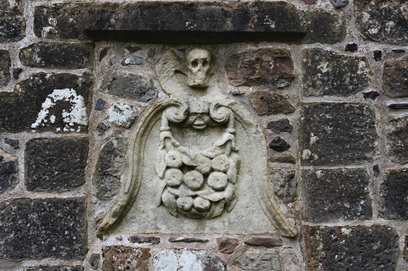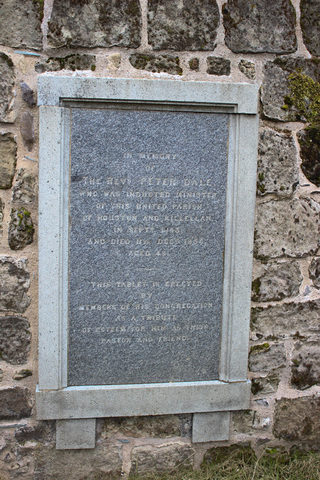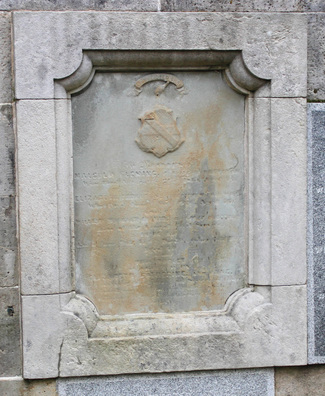Or read all about it below....
Grave stone - with sword inscription
|
This recumbent stone has a simple inscription of a sword and a part of a shaft possibly from a cross. This form and style of stone would suggest a possible 13th century date. The symbol of a sword can identify the grave as that of a knight but knight's grave stones are often more elaborate. There is a tradition of elaborately carved gravestones from the west of Scotland from the medieval period and there are good examples at Sadell Abbey on the Mull of Kintyre, Kilmartin, Iona and on Islay. There are also a number of simpler stones similar to the one from Kilallan from Dumfries and Galloway. An example of a sword alongside a round headed cross was found near St Cyrus to the south of Stonehaven and it is now in the collection of Marischal College Museum, Aberdeen. Later on an inscription of a sword was used on the graves of army officers. Sometimes if a sword is found alongside inscriptions of other tools it may be the grave of a soldier in a local militia who combined his part-time military duties with another trade.
|
West gable - Infilled mullion window
|
This window was probably inserted as part of the renovations that were undertaken in 1635. The window consists of a bottom window sill, a top lintel stone with two upright stones on either side. The window is divided into two with a central mullion stone. All these stone are very similar to look at and were probably carved or dressed at the same time for this window. On the inside the sides of the window splay outwards to let light into the church.
|
Doorway - lintel with 1635 date
|
This worn and abraded stone commemorates the renovation of the church in 1635. These renovations were quite substantial and involved the insertion of the now blocked windows and a new door at the east end of the south wall of the church and the now blocked window in the west gable . The original doorway in the north wall was probably blocked at this time. These substantial renovations took place during a period of religious conflict and disruption in Scotland.
|
Middle doorway Memorial (19) - Plaque mounted on wall to right of door
|
This plaque commemorates the Reverend James Hutcheson who was ordained minister for the parish of Kilallan on 13.11.1649, 14 years after the renovations to the church and died on 5.2.1706 at the age of 81. This means that he was born in 1625 and that he was 24 years old when he became minister for Kilallan and remained as minister for 57 years.There is also a Poll tax return for him in 1695 that names his wife as Margaret Gilhugie
The Reverend James and Margaret Hutchison lived through very troubled times with religious division and political unrest. When he was born Charles I, who was part of the Stewart dynasty, was king of Scotland, England and Ireland. There followed a period of unrest which lead to the Civil War, Oliver Cromwell's military campaigns in Scotland and the execution of Charles I in 1649 the same year that James Hutchison was ordained minister. This period ultimately lead to the end of the Stewart dynasty which in turn lead to the rise of the Jacobites and the 1715 and 1745 uprisings. Reverend Hutchison was also involved in the Paisley Witch trials that took place in February 1697 where he delivered a sermon to the court. Seven of the accused were later found guilty and sentenced to death, one committed suicide and the remaining six were hanged and their bodies burned at Gallow Green in Paisley. Witch trials occurred throughout Europe in the 17th century and seem to be a response to political and religious unrest, war and poor harvests that created a climate of fear. In Scotland things seem to have got out of control and Scotland executed more witches than the rest of Europe put together but the Paisley witch trials marked the end of the large trials. |
Memorial tablet with skull, wreath and green man figure
|
This highly decorative memorial stone contains several images that represent different things, the carving of a skull represents death and mortality, signifying that no-one can avoid death. While the garland or wreath of flowers and foliage represents victory over death. The face within the garland is that of 'a green man' which is an old figure that appears on church buildings from medieval times and represents regeneration and immortality. These symbols were quite common in the 17th and 18th centuries.
|
East of church flat/ledger stone with headstone
|
This grave is of Wm Mclean(?) and Isobal Adam and features carvings of tools that would indicate his trade. In this instance the tools are a miller's rhynd and a shovel. A miller's rhynd is the metal clasp used to fasten a millstone in place and a shovel was used both by millers and maltsters for spreading out grain.
|
East gable - Memorial tablet to Rev Peter Dale d1856
|
This memorial tablet mounted on the east gable wall facing the congregation is to the Reverend Peter Dale who was minister of Houston and Kilallan from September 1843 until his death on 11.12.1856 at the age of 48, he would have been 35 years old when he became minister. By this time the church services would have been held at Houston and the church at Kilallan was probably roofless and only used for burials.
|
East gable - memorial stone to Wilhemina Fleming Dale d1853
|
This free standing gravestone is to the memory of Wilhemina Fleming Dale who was born 23.9.1852 and died 1.10.1853 aged 13 months. This presumably marks the grave of the minister's daughter. Unfortunately there is no mention on either stone to the minister's wife but the inclusion of Fleming in the daughter's name would suggest that the minister may have married into the family of the Flemings of Barochan.
|
Barochan Aisle - Memorial tablet to Jane Fleming 1868
|
This wall mounted tablet is to the memory of Jane and Catherine Fleming, daughters of Malcolm and Elizabeth. They were both presumably unmarried as there is no reference to husbands or children on the tablet. Jane died 15.2.1868 aged 71 and Catherine died 23.11.1863 aged 78. Both would have lived through the Napoleonic Wars including the battle of Trafalgar and the coronation of Queen Victoria in 1838.
|
Barochan Aisle - Memorial tablet to Malcolm Fleming and family
|
This wall mounted tablet is dedicated to Malcolm Fleming of Barochan who died on 21 November 1819 at the age of 74, this means that he was born in 1745 and would have grown up in the aftermath of Culloden and the Jacobite rebellion. His wife was Elizabeth Ferguson originally from Doonholm who died on 23 June 1826 aged 76. Also their son William Malcolm Fleming esquire of Barochan late of the Bengal Service, born 9.5.1782 and died 4.10.1852 at the age of 70. He was survived by his daughters Elizabeth, Catherine and Jane.
The Bengal Service was part of the East India Company based in Calcutta and consisted of military units mainly light cavalry. Not long after his death these units were involved in the Indian Mutiny of 1857. They were later absorbed into the British Army when the British Government took over in India from the East India Company. |
Grave stone (22) - A sandstone table tomb
|
This grave stone is dedicated to the memory of John Whitehill who died in 1786 and his wife Martha Fulton and they lived at Hallridge. This type of gravestone is known as a table tomb or 'through stane' as it consists of a flat stone that has the inscription and is supported at the corners by stone legs. The table stands over the grave.
|











